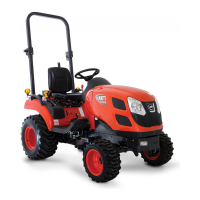wheel operation can be somewhat
difcult. Operate the steering while
tractor is in motion.
3. When a loader is mounted, adjust
the air pressure of the front wheel
to its maximum specification and
mount weight or implement on the
3 point hitch of the tractor, and re-
move the front weight to make the
front and rear balance more stable
for safe working.
4. When turning the steering wheel to
its end, the operating sound of the
safety valve (relief valve) can be
heard. Do not continuous to oper-
ate the steering wheel to a maxi-
mum right or left turn when you
hear the relief valve continually.
(OK for a short period of time). The
temperature of the hydraulic fluid
may rise, causing malfunctions.
The non-load reaction type means
that the reaction force or impact
applied to the front axle is not
transferred to the steering wheel.
Therefore, this function prevents
the steering wheel from return-
ing to its original position by the
resistance applied to the front
wheels when turning.
These characteristics are suit-
able for tractors which are driven
mostly at a low speed. The features
low reaction force of the steering
wheel can reduce the operator’
s fatigue during work in which
frequent turning is required. How-
ever, it may be inconvenient when
driving at a high speed as the
steering wheel is not automatical-
ly returned to its straight-ahead
position after turning.
NOTE
The power steering system in this
tractor is a non-load reaction, full
hydraulic type.
The full hydraulic system means
that power necessary for power
steering is transferred by hydrau-
lic fluid only and therefore me-
chanical devices, such as racks
and pinions, are not installed
to the tractor. This function pre-
vents the steering wheel from
returning to its original position
by the resistance applied to the
front wheels which are hydrauli-
cally, not mechanically, linked to
the steering wheel. Therefore,
the angle of the KIOTI emblem
on the center of the steering
wheel may differ occasionally,
which is normal.
NOTE

